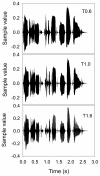Effect of spectral normalization on different talker speech recognition by cochlear implant users
- PMID: 18529199
- PMCID: PMC2676177
- DOI: 10.1121/1.2897047
Effect of spectral normalization on different talker speech recognition by cochlear implant users
Abstract
In cochlear implants (CIs), different talkers often produce different levels of speech understanding because of the spectrally distorted speech patterns provided by the implant device. A spectral normalization approach was used to transform the spectral characteristics of one talker to those of another talker. In Experiment 1, speech recognition with two talkers was measured in CI users, with and without spectral normalization. Results showed that the spectral normalization algorithm had small but significant effect on performance. In Experiment 2, the effects of spectral normalization were measured in CI users and normal-hearing (NH) subjects; a pitch-stretching technique was used to simulate six talkers with different fundamental frequencies and vocal tract configurations. NH baseline performance was nearly perfect with these pitch-shift transformations. For CI subjects, while there was considerable intersubject variability in performance with the different pitch-shift transformations, spectral normalization significantly improved the intelligibility of these simulated talkers. The results from Experiments 1 and 2 demonstrate that spectral normalization toward more-intelligible talkers significantly improved CI users' speech understanding with less-intelligible talkers. The results suggest that spectral normalization using optimal reference patterns for individual CI patients may compensate for some of the acoustic variability across talkers.
Figures







References
-
- Bond, Z. S., and Moore, T. J. (1994). “A note on the acoustic-phonetic characteristics of inadvertently clear speech,” Speech Commun. SCOMDH10.1016/0167-6393(94)90026-4 14, 325–337. - DOI
Publication types
MeSH terms
Grants and funding
LinkOut - more resources
Full Text Sources
Medical

